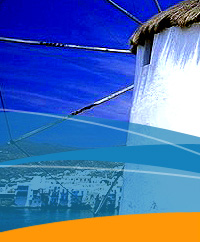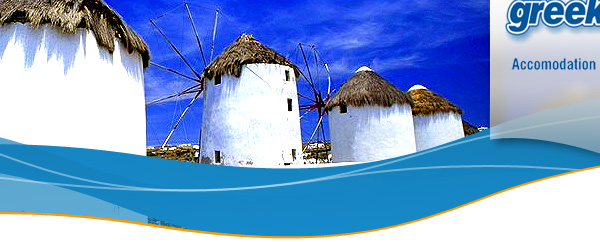|
 |
|
 |
| |
 |
Lipsi Island |
Information on Lipsi holidays - Greece |
| |
|
|
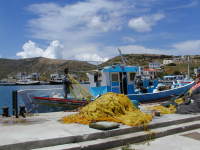 Lipsi is a tiny island covered with white washed houses and little churches with blue domes. It is an island where cars are almost non-existent and where most of the local life takes place at the island's port.
Lipsi is a very beautiful and authentic island of the Dodecanese where during the day you can watch the fishermen beat octopuses on the quays that will be served later that night in one of the many cafes set on the tiny port. Lipsi is a tiny island covered with white washed houses and little churches with blue domes. It is an island where cars are almost non-existent and where most of the local life takes place at the island's port.
Lipsi is a very beautiful and authentic island of the Dodecanese where during the day you can watch the fishermen beat octopuses on the quays that will be served later that night in one of the many cafes set on the tiny port.
|
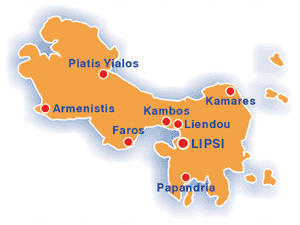 |
|
 |
 |
 |
 |
About Lipsi island! |
|
 |
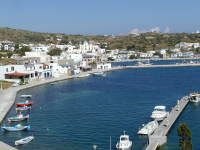 Lipsi are a cluster of islets in the southeastern Aegean, located north of Leros and east of Patmos . Their name is taken from the name of the largest island, Lipsi or Lipsos, which consists of two landmasses, joined together by a narrow 400 meter wide neck. It is the only inhabited island with a total surface of 16 sq. kms, 36 kms of coastline and a population of about 600 inhabitants. Around the main island, Lipso, 24 islets and 6 rocky peaks make up an impressive island group. Lipsi is a tranquil little island still untouched by mass tourism. That is why it is an ideal place for anyone wishing to spend their holidays peacefully and enjoy the sun, the sea and the company of the friendly and hospitable islanders. The island's size is such, that you will be able to get anywhere on the island on foot. Lipsi are a cluster of islets in the southeastern Aegean, located north of Leros and east of Patmos . Their name is taken from the name of the largest island, Lipsi or Lipsos, which consists of two landmasses, joined together by a narrow 400 meter wide neck. It is the only inhabited island with a total surface of 16 sq. kms, 36 kms of coastline and a population of about 600 inhabitants. Around the main island, Lipso, 24 islets and 6 rocky peaks make up an impressive island group. Lipsi is a tranquil little island still untouched by mass tourism. That is why it is an ideal place for anyone wishing to spend their holidays peacefully and enjoy the sun, the sea and the company of the friendly and hospitable islanders. The island's size is such, that you will be able to get anywhere on the island on foot.
The island's unique settlement is located rougly aroung the center of the island, deep along the well-protected bay bearing the island's name. Behind the port is the picturesqe town of Lipsi with its white washed houses and blue shutters. At the center of the town is the impressive church of 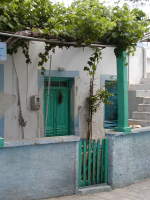 Ag. Ioannis Theologos (St. Ag. Ioannis Theologos (St. 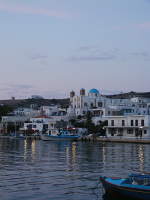 John the Theologician) with its blue dome and two bell towers. There, in a ground floor hall, is the archaeological collection of Lipsi, well worth visiting. One of the most significant old churches of the island is "Panaghia of Charos" (Virgin Mary of Death), built around 1600. The church was named after the original icon of Virgin Mary who holds the crucified Christ in her arms. The church celebrates the feast of the Virgin on August 23rd and for the locals this day is celebrated at the two squares of the village with traditional music and dances. Other settlements on Lipsi are those of Kouselio, Katsadia, and Platys Gialos. John the Theologician) with its blue dome and two bell towers. There, in a ground floor hall, is the archaeological collection of Lipsi, well worth visiting. One of the most significant old churches of the island is "Panaghia of Charos" (Virgin Mary of Death), built around 1600. The church was named after the original icon of Virgin Mary who holds the crucified Christ in her arms. The church celebrates the feast of the Virgin on August 23rd and for the locals this day is celebrated at the two squares of the village with traditional music and dances. Other settlements on Lipsi are those of Kouselio, Katsadia, and Platys Gialos. |
 |
 |
 |
 |
Lipsi History |
|
 |
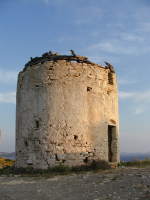 The history of Lipsi is inseparable from the history of the larger neighboring islands and especially that of Patmos. The name Lipsi is ancient and it is encountered as "Lipsia" on ancient inscriptions. Lipsi seems to have been inhabited from pre-historic times until today. Clay pots and inscriptions dating back to classical times, have been found on various parts of the island. In 1370 B.C. the Kares inhabit the island while 170 years later, the Dorians occupy the island around 1200 B.C. After them, the Ionians take over the rule for several decades. Remains and various findings that were found on a hill, testify that around the 4th century B.C. there must have existed a small town up since the location was a natural castle. In 730 A.D. Lipsi becomes part of the then Byzantine state. From there on and until the 11th century A.D. we lose trace of the island's history, because like many other islands of the Aegean sea, it was deserted. During the 11th century A.D. the neighboring island of Patmos is given over to St. Christodoulos (where he builds the Monastery of St. John the Evangelist and Theologician), along with the island of Lipsi. The history of Lipsi is inseparable from the history of the larger neighboring islands and especially that of Patmos. The name Lipsi is ancient and it is encountered as "Lipsia" on ancient inscriptions. Lipsi seems to have been inhabited from pre-historic times until today. Clay pots and inscriptions dating back to classical times, have been found on various parts of the island. In 1370 B.C. the Kares inhabit the island while 170 years later, the Dorians occupy the island around 1200 B.C. After them, the Ionians take over the rule for several decades. Remains and various findings that were found on a hill, testify that around the 4th century B.C. there must have existed a small town up since the location was a natural castle. In 730 A.D. Lipsi becomes part of the then Byzantine state. From there on and until the 11th century A.D. we lose trace of the island's history, because like many other islands of the Aegean sea, it was deserted. During the 11th century A.D. the neighboring island of Patmos is given over to St. Christodoulos (where he builds the Monastery of St. John the Evangelist and Theologician), along with the island of Lipsi. |
 |
|
| |
| |
|
| |
| [back to top] |
|
 |
|
|


